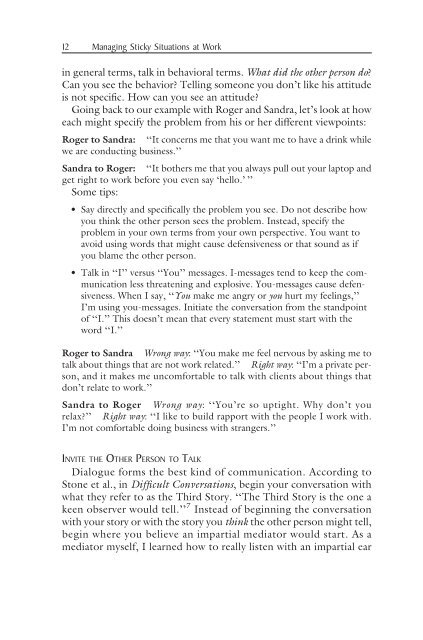Managing Sticky Situations at Work
Managing Sticky Situations at Work
Managing Sticky Situations at Work
Create successful ePaper yourself
Turn your PDF publications into a flip-book with our unique Google optimized e-Paper software.
12 <strong>Managing</strong> <strong>Sticky</strong> <strong>Situ<strong>at</strong>ions</strong> <strong>at</strong> <strong>Work</strong>in general terms, talk in behavioral terms. Wh<strong>at</strong> did the other person do?Can you see the behavior? Telling someone you don’t like his <strong>at</strong>titudeis not specific. How can you see an <strong>at</strong>titude?Going back to our example with Roger and Sandra, let’s look <strong>at</strong> howeach might specify the problem from his or her different viewpoints:Roger to Sandra: ‘‘It concerns me th<strong>at</strong> you want me to have a drink whilewe are conducting business.’’Sandra to Roger: ‘‘It bothers me th<strong>at</strong> you always pull out your laptop andget right to work before you even say ‘hello.’ ’’Some tips:• Say directly and specifically the problem you see. Do not describe howyou think the other person sees the problem. Instead, specify theproblem in your own terms from your own perspective. You want toavoid using words th<strong>at</strong> might cause defensiveness or th<strong>at</strong> sound as ifyou blame the other person.• Talk in ‘‘I’’ versus ‘‘You’’ messages. I-messages tend to keep the communic<strong>at</strong>ionless thre<strong>at</strong>ening and explosive. You-messages cause defensiveness.When I say, ‘‘You make me angry or you hurt my feelings,’’I’m using you-messages. Initi<strong>at</strong>e the convers<strong>at</strong>ion from the standpointof ‘‘I.’’ This doesn’t mean th<strong>at</strong> every st<strong>at</strong>ement must start with theword ‘‘I.’’Roger to Sandra Wrong way: ‘‘You make me feel nervous by asking me totalk about things th<strong>at</strong> are not work rel<strong>at</strong>ed.’’ Right way: ‘‘I’m a priv<strong>at</strong>e person,and it makes me uncomfortable to talk with clients about things th<strong>at</strong>don’t rel<strong>at</strong>e to work.’’Sandra to Roger Wrong way: ‘‘You’re so uptight. Why don’t yourelax?’’ Right way: ‘‘I like to build rapport with the people I work with.I’m not comfortable doing business with strangers.’’INVITE THE OTHER PERSON TO TALKDialogue forms the best kind of communic<strong>at</strong>ion. According toStone et al., in Difficult Convers<strong>at</strong>ions, begin your convers<strong>at</strong>ion withwh<strong>at</strong> they refer to as the Third Story. ‘‘The Third Story is the one akeen observer would tell.’’ 7 Instead of beginning the convers<strong>at</strong>ionwith your story or with the story you think the other person might tell,begin where you believe an impartial medi<strong>at</strong>or would start. As amedi<strong>at</strong>or myself, I learned how to really listen with an impartial ear















